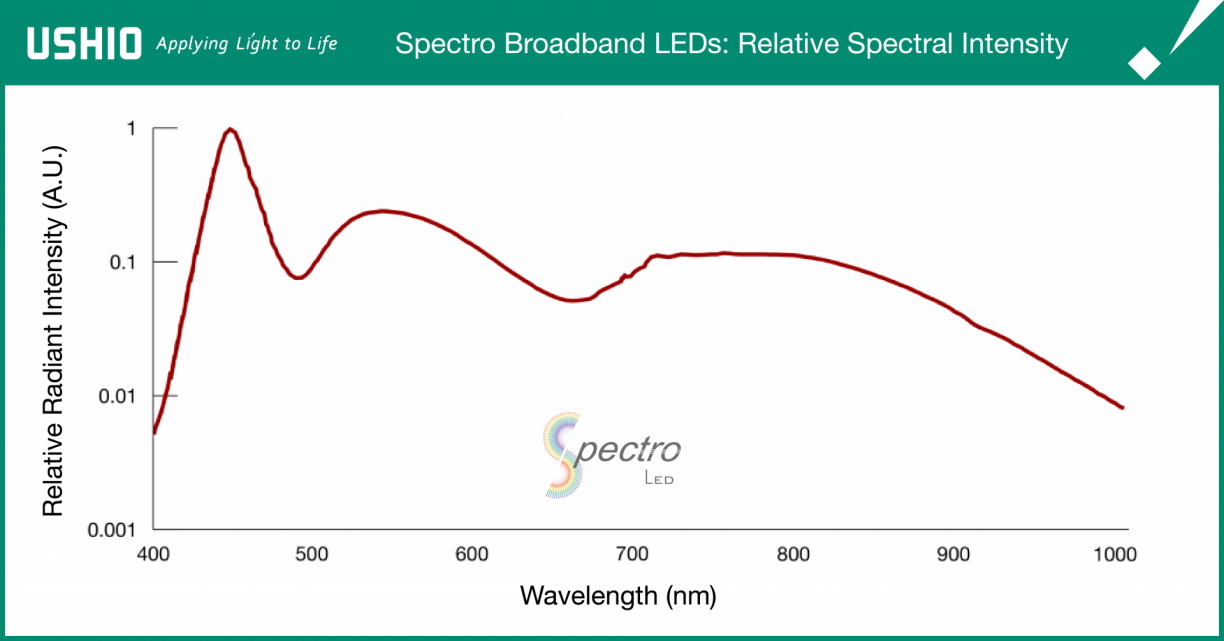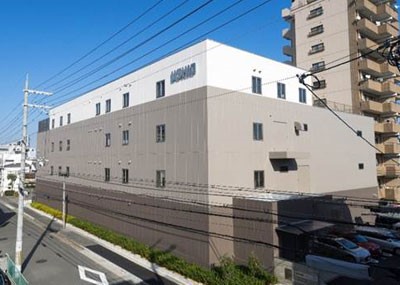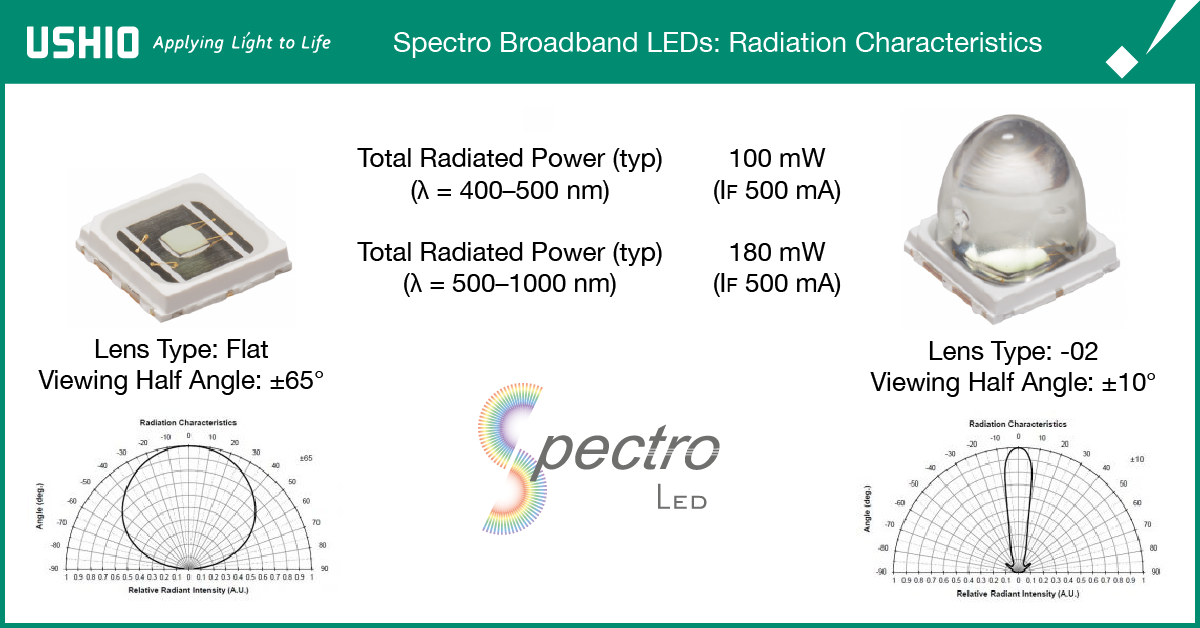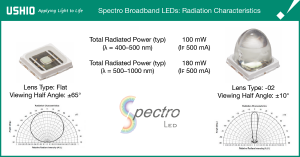Ushio’s redefinition of hyperspectral light sources drives established applications into a new direction
Repeatedly breaking the output power record for broadband LEDs, which was set at 180 mW in 2021, Ushio’s Spectro series has become a staple for manufacturers of hyperspectral imaging, optical food sorting, and machine vision equipment. Having set the previous record of 160 mW, in 2019, Ushio has continued to drive innovation forward with persistent improvements to its own LED technology.
Spectro broadband LEDs emit wavelengths in the 400–1000 nm range, which covers the visible light and near-infrared (NIR) spectrum. Ushio’s copper-heatsinked 5 mm x 5.2 mm SMBB packages dissipate heat efficiently and offer a variety of lens options. The 1 mm x 1 mm indium gallium nitride (InGaN) chip achieves its record output power of 180 mW by combining the illuminated chip with a phosphor lens. A choice of silicone resin lenses are available as standard — ‘flat type’ for a ±65° viewing half angle, or the rounded ±10° ’02 type’. Spectro broadband LEDs are also available without a lens.

Technical specifications of Ushio’s Spectro broadband LED series
- World’s highest optical output power for a broadband LED
- Hyperspectral: 400–1000 nm (Visible to NIR)
- Compact, 5 mm x 5.2 mm SMBB-type LED package
- Customization requests are welcome
- Easily integrated into OEM devices
- Stable spectrum under various temperatures and forward currents
- Top level heat dissipation
- Long-life compared to conventional halogen alternatives
- Multiple broadband LED chips can be implemented to achieve required output power
Potential applications for Ushio’s hyperspectral broadband LEDs
Ushio’s Spectro LEDs are designed to work in tandem with photo-detecting sensors and hyperspectral imaging cameras. Capturing the spectral absorption properties of common materials allows automated systems perform categorization, quality assurance, and other sorting tasks. Potential applications include detecting moisture content within an object, such as detecting bruises in food grading applications, or monitoring the liquid fill level of a medicine bottle.
There are countless applications for Spectro broadband LEDs, like inspecting the sugar content of an apple or analyzing the amount of oxygen in a blood sample. Since they emit visible light, as well as near-infrared, the number of potential applications for broadband LEDs are constantly rising. The hyperspectral emission of Spectro LEDs roughly matches the sensitivity of the CMOS photo-detectors commonly found in sensing devices, which makes them ideal for integration into production lines.
Particularly in the case of analysis, inspection, and machine vision applications, Ushio’s LED experts can help you find the right solution for you. Indeed that may be the Spectro broadband LED series, or perhaps the team might recommend the Epitex D series SWIR LEDs. Whatever the desired outcome, contact Ushio today if you are looking to source a hyperspectral light source for any of these applications:
- Blood oxygen saturation analysis
- Detection of foreign matter
- Endoscopic procedures
- Food grading and sorting
- Hyperspectral imaging
- Instrument diagnostics and research execution
- Machine vision
- Optical sorting (by raw material, by color, etc.)
- Photodynamic therapy
- Spectroscopy
- Substance / matter analysis
Ushio’s continued development waves goodbye to old broadband LED weaknesses
As miniaturization continues to evolve, the expectations of portable devices have become an outright demand by consumers and industrial businesses alike. Until fairly recently, many LEDs on the market were able to eliminate the bulky size and excessive heat issues that are synonymous with halogen lamp solutions; however, they were still held back by a relatively weak output in comparison to halogen lamps.
The Spectro LED series now offers a higher output power, and consequently, accuracy in measurement and analysis has increased dramatically. The construction of the SMBB package means that there is no need for a heat-dissipation jig to accompany it, so the excessive heat of other technologies is not a serious issue. Additionally, previous LED generations required multiple LED packages, but this is no longer necessary to cover a hyperspectral wavelength band, thanks to the implementation of a phosphor that ensures a continuous and stable spectrum extending from violet-visible to NIR.
Broadband LEDs are the hyperspectral solution for analysis & measurement
Developed by Ushio, Inc. in Kyoto, Japan, the Spectro broadband LED series is established in the food and medicine production industries as a reliable light source in sorting and quality control systems. The absorption characteristics of near infrared (NIR) light differ from one substance to another, so these LEDs lend themselves well to applications, such as determining the type and quantity of a substance.

Ushio’s Laser Diode and LED production facility, in Kyoto, Japan.
Simultaneously identifying multiple materials, each with a different peak light absorbency, is possible by deploying separate LED and sensor packages to illuminate and detect each respective material independently. A popular solution for this is Ushio’s multi-chip SWIR LEDs, such as the Epitex D series. The D series can house up to three narrowband chips, each emitting a different wavelength. So why would you need a broadband LED?
The main reason to opt for a broadband LED light source is the single-chip hyperspectral output. By using CMOS sensors to detect how much of the broadband emissions are absorbed by the target subject, it is possible to identify multiple materials within a substance with a single broadband LED. Not only can this technique make it possible to recognize multiple materials within a substrate, analysis of the resulting data can also provide accurate quantitative measurement.

Contact Ushio for advice on all hyperspectral lighting applications
If you would like to make an inquiry regarding Ushio’s record-breaking Spectro broadband LED series, or any other hyperspectral lighting requirement, contact Ushio’s regional experts via the following links:
Americas: https://www.ushio.com/contact-us/
Asia: https://member.ushio.co.jp/en/members/contact/product-led
Europe, Middle East, and Africa (EMEA): https://www.ushio.eu/contact/

